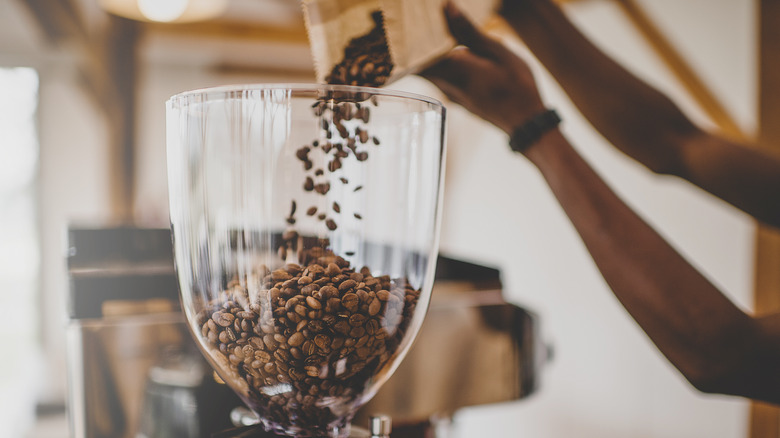How Often To Clean Your Grinder For The Perfect Tasting Coffee
If you're hoping to make an A-grade cup of coffee, it's not just about buying from the best coffee brands. You need to keep your coffee-making equipment clean so that you get the freshest tasting brew, and that includes your grinder. But how often?
It'll depend on a couple of factors: How much coffee you make, and whether you're using oily beans (that usually means darker roasts). Opinions vary but if you're making just one or two cups per day at home, once a month is probably fine — but a little more often if you're using darker (read: Oilier) beans, and as often as once a week if you're making coffee more frequently and with dark roasts. You can also do a less-intense clean more frequently, like running a cleaning substance through the grinder (at least once a month, but as often as once a week), and then take the grinder apart and clean it more thoroughly less often, like once every two months.
It may depend a little bit on how seriously you take your coffee: If you're really intense about brewing coffee perfectly, some experts argue that you should clean your grinder every three days or less (since that's approximately how long it takes coffee to go stale when exposed to the air). And while that's reasonable for a coffee shop with high output, it's probably a little excessive for someone making a couple of cups a day at home.
Why do coffee grinders need cleaning, anyway?
It might not seem obvious that you need to regularly clean a coffee grinder. A coffee maker, sure, since it has water flowing through it, which can cause issues like mineral build-up, but a grinder stays dry and all you need to do is occasionally brush off some of those coffee grounds, right?
Not exactly: Ground coffee may feel dry, but as you might have guessed, it contains oils. When you grind beans, those oils coat the grinding mechanisms, and they can turn rancid or stale as they're exposed to the air; they also tend to absorb other scents and flavors from the environment around them. If your grinder isn't cleaned, the unpleasant taste of that stale residual oil can then find its way into your fresh-ground coffee, making for a decidedly less tasty brew.
Bear in mind that the longer a bean is roasted, the more oils it usually has, because the roasting process pushes the oils to the exterior of the bean — hence why coffee grinders that process darker roasts need to be cleaned more frequently. Dark roast coffee beans also tend to be shinier than lighter-roasted beans.
How to clean your coffee grinder
The best cleaning method depends on the type of grinder you have. For blade grinders, which tend to be cheaper and usually feature a spinning blade that grinds the beans, you can buy special products to clean it. These usually look like pellets or coffee beans that absorb the oils from the grinder. Some sources also suggest using plain, uncooked rice, which is similarly absorbent, although some coffee pros warn that this could damage a grinder since rice grains are harder than coffee beans — pre-cooked options that are still dry, like minute rice or instant rice, may be fine, though.
If you have a burr grinder, which is sometimes considered a more upscale machine for superior coffee, you may be able to use similar cleaning substances, but it's more often recommended to take the grinder apart and clean all the parts individually. Some parts, like the hopper, can be washed in soapy water, but the metal parts (such as the burrs) shouldn't be cleaned in water, as they can rust — a damp brush should be okay, though. If you're unsure, check the manual that came with the grinder.


